The Celluloid Musashi Part II:
Pre-War & War-Time Musashi
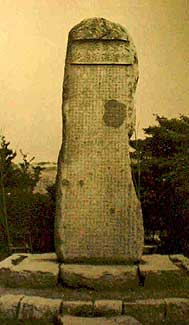 Eiji Yoshikawa's famous novel about the life of Musashi Miyamoto was elaborated to large extent from a long text of a memorial erected on a hill called Temuka in Kokura shortly after Musashi's death, & moved in the Meiji period to Enmyo-ji, the Ogasawara family temple, where it stands today.
Eiji Yoshikawa's famous novel about the life of Musashi Miyamoto was elaborated to large extent from a long text of a memorial erected on a hill called Temuka in Kokura shortly after Musashi's death, & moved in the Meiji period to Enmyo-ji, the Ogasawara family temple, where it stands today.
As it would be rather odd to put up a memorial that noted uncouthness, lack of cleanliness, & a trickster personality, this memorial was the first attempt to present a generous portrait of Musashi, though in a couple of passages it is even so more honest than Yoshikawa's novel, or at least ambiguous about aspects of Musashi's life that were unfavorable.
An early film version of Musashi's life inspired by the text accompanying the monument was Musashi Miyamoto (Miyamoto Musashi, Chie Productions, 1929), directed by Kintaro Inoue. It was not Inoue but the scenarist for this & several other of Chiezo Kataoka's films of the late 1920s & 1930s, namely Mansuke Itami, who first began to reshape Musashi's image, formerly regarded as a slovenly & sneaky with great skill but dubious honor.
Itami wrote many wry, satirical scenarios for Chiezo, & this period of the actor's career embodied the best of his performances due to Itami's brilliance. Alas, most of Chiezo's work from this era was lost in the fire-bombing of Tokyo, or destroyed during the Occupation by Macarthur, & what little survives is not much available outside Japan.
The next year Chiezo took his second outing as Musashi Miyamoto (Miyamoto Musashi, Chie Productions, 1930) with an eventual sequel Return of Musashi Miyamoto (Miyamoto Musashi Zoku, 1934).
His director for these was the well-famed Mikio Naruse, whose greatest creativity was not with chambara; rather, he excelled in romantic or domestic tales of women's lives.
Chiezo would reprise the role in Musashi Miyamoto: The Earth Scroll (Miyamoto Musashi: Chi no Maki, Nikkatsu, 1938) directed by Jun Ozaki. The title Earth Scroll refers to one of the chapters of Musashi's Book of Five Rings.
Youthful Chiezo made a handsome, nicely groomed wandering Musashi. He had become well enough identified with the "cleaned up" Musashi that when Yoshikawa's novel was adapted to the screen, Chiezo was already primed & ready for the role.
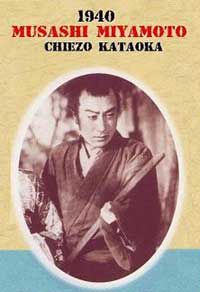 Musashi fascinated director Hiroshi Inagaki for a good portion of his filmmaking career. He made his black & white Musashi Miyamoto trilogy (Nikkatsu Kyoto, 1940) with Chiezo Kataoka in the title role. Kojiro is played by the comparatively gaunt, elegant Tsukigata Ryunosuke. Musashi's girlfriend Otsu is Chikako Miyagi. Musashi fascinated director Hiroshi Inagaki for a good portion of his filmmaking career. He made his black & white Musashi Miyamoto trilogy (Nikkatsu Kyoto, 1940) with Chiezo Kataoka in the title role. Kojiro is played by the comparatively gaunt, elegant Tsukigata Ryunosuke. Musashi's girlfriend Otsu is Chikako Miyagi.
The 1940 productions were started the instant the original serial publication was completed, & the three films were indidividually titled:
Musashi Miyamoto I: The Pioneers (Miyamoto Musashi: Kusawake no hitobito, 1940); Musashi Miyamoto II: Gateway to Success (Miyamoto Musashi: Eitatsu no mon, 1940); Musashi Miyamoto III: The One Road of Sword & Mind (Miyamoto Musashi: Kenshin Ichiro, 1940). This was followed by something of a coda to the trilogy, Duel at Ichijo Temple (Ichijoji no Ketto, Nikkatsu, 1942). Parts One & Two are sometimes indexed as a single film, so that Part Three becomes Part Two, & Part Four becomes Part Three, so it all gets defined as a trilogy.
Chiezo had previously played scruffy warriors similar to Musashi of history. In The Vagabond Gambler; aka, The Wandering Gambler (Horo Zanmai, Nikkatsu, 1928), one of Inagaki's earliest triumphs, Kataoka's natural good looks were well disguised. Inagaki directed him as a menacing, frightening swordsman with wild hair & intense posture. That was much more like the historical Musashi than than when Chiezo actually played Musashi!
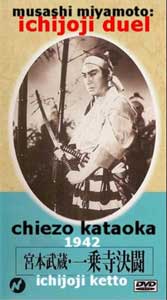 But in Vagabond Gambler Chiezo was playing a toseinin or peasant wanderer rather than a samurai. Chambara directors had always been willing to let these commoner-swordsmen be portrayed as unruly & badly groomed. But in Vagabond Gambler Chiezo was playing a toseinin or peasant wanderer rather than a samurai. Chambara directors had always been willing to let these commoner-swordsmen be portrayed as unruly & badly groomed.
For the character of Musashi, Inagaki preferred a reprisal of Kataoka's 1930 portrayal, a fairly clean-cut & groomed fellow. This fib has been incorporated into most but not all of the many films about Musashi since, which at most portray his unruly youth before tamed & instructed by a Buddhist priest, but thereafter noble in bearing with perfectly pressed hakama trousers & tidily arranged hair.
With photography by the genius Kazuo Miyagawa (Rashomon, Gate of Hell, etc), Inagaki's 1940s trilogy was his superior version. His famed post-war remake was much more commercially inclined, although it followed the 1940 script so is a true remake.
Regardless of its artistic merits, the Eighth Army Headquarters of General MacArthur saw fit, during the Occupation, to destroy prints & negatives of the original trilogy, along with over two hundred other films which upheld feudal values.
Perhaps if Inagaki hadn't white-washed Musashi's more vulgar attributes, the films would have been saved for revealing the appalling nature of the feudal swordsman. As it is, we have at least the second portion of the trilogy, a rediscovered copy now in the Tokyo National Museum of Modern Art (& one of the illustrations here is of an old video release). The 1942 added installment also survives.
Inagaki also took Musashi's nemesis & told his story in a separate trilogy, Sasaki Kojiro I, II, III (Morita Productions, 1950-1951), later remaking that into the single film Kojiro (Sasaki Kojiro, 1967) in color. These films will be discussed in a separate article.
The four Kojiro films together with the famed Samurai Trilogy with Toshiro Mifune add up to an even dozen feature films that Inagaki made about Musashi. The pivotal duel on Ganryu Island was staged in four of these twelve films.
Remakes, by the way, are an intrical part of the Japanese approach to cinematic art & business, so there is nothing exceptional about the number of times Musashi's story has been filmed. The story of the 47 Ronin, of the Shinsen group, & the Robin Hood-like gambler Chuji of Kunisada, provide events & characters filmed much, much more often than the life of Musashi.
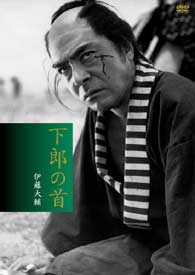 The military government demanded films with a certain leaning & for a while the entire film industry was geared toward pleasing the warmongers, something that was equally the case in America. The military government demanded films with a certain leaning & for a while the entire film industry was geared toward pleasing the warmongers, something that was equally the case in America.
While Hollywood portrayed the infamy of Japanese soliders who supposedly started it all, Japan was making period pieces which revealed in a propogandistic manner the historical reasons Japan was forced into imperialism out of defense against, commonly, the evil British.
Daisuke Ito had previously denounced feudal & warlike values in Servant (Gero, Nikkatsu, 1927) & Man-Slashing Horse-Piercing Sword (Zanjin Zamba Ken, Nikkatsu, 1930), with an attitude no director dared reveal during the war without considerable risk from the watchful military.
A little over one-fifth of the latter film Man-Slashing Sword survives. Gero unfortunately is lost. However, Ito remade it after the war, when it was again possible to criticise militarism without getting sent to the front as punishment. The remake Neck of the Servant (Gero no kubi, 1955) is an absolutely brutal indictment of the warrior mentality & the position of the lower classes in a warrior society.
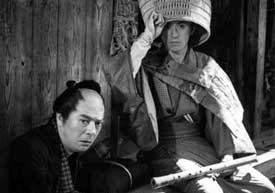 Totsuhei (Tazaki Jun) is a spear-carrier for a young samurai, Shintaro (Akihiko Katayama). Totsuhei (Tazaki Jun) is a spear-carrier for a young samurai, Shintaro (Akihiko Katayama).
When Totsuhei is mistakenly assumed to be having an affair with Shintaro's mother, the father Gansetsu (Sakae Ozawa) attacks the faithful & innocent servant, & alarmed Totsuhei accidently kills his master.
Young Shintaro, obedient to the requirements of his class, has no choice but to avenge his father, & there is no chance of justice or understanding for Totsuhei.
The final assault of the poor spear carrier is tragic & bloody. Ito told other stories with the same theme of warrior injustice to admiring, faithful servants, one of the best of his last period of filmmaking being The Retaliation of Gonza (Kuno kubi ichiman-goku, 1963).
But during the war in China & the Pacific, Daisuke Ito was forced to drop his scathing attacks of Tokugawa militarism & focus on something more, uhm, "constructive."
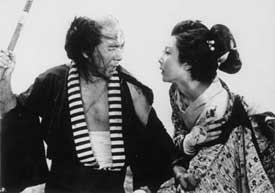 Thus in Kurama Tengu Appears in Yokohoma (Kurama Tengu Yokohama ni Arawaru, Daiei, 1942), a gang of ronin defeat foreign interests in the early days of British corruption & illegal smuggling, with reference to the villainous sale by the British of heroin & opium to China, followed by Britain's imperial expansion. Thus in Kurama Tengu Appears in Yokohoma (Kurama Tengu Yokohama ni Arawaru, Daiei, 1942), a gang of ronin defeat foreign interests in the early days of British corruption & illegal smuggling, with reference to the villainous sale by the British of heroin & opium to China, followed by Britain's imperial expansion.
And it wasn't even an historical exaggeration! Britain threatened war against China when the government tried to stop British import of opium & heroin. And the Japanese had not been paranoid in assuming a similar agenda was likely.
This was the tone of almost every wartime period drama, either in praise of devotion to a military government, or using historical acts of perfidy by the west against the east as proof of what Japan must fight against.
And when the American "black ships" forced Japan to open to the west after centuries of closed-door policy, there was no ambiguity about what the west wanted: Enter into trade with us, to our exclusive benefit, or we will use our superior canons to blow your coastal cities to kingdom come.
Thus with tremendous upheaval the Tokugawa regime came to an end, the Meiji Restoration refashioned Japan in many ways as a western nation of the east, & the Japanese set out to beat western imperialists at their own game of guns & exploitation.
So Daisuke Ito, formerly critical of militarism, adapted the story of Musashi to what the government required, showing how enobling militarism was for Japan in the past, & therefore must be so in the present.
These films are Initiation to the Two-Sword Style (Nitoryu Kaigen, Daiei, 1943) & Duel at Hannya-zaka (Ketto Hannya-zaka, Daiei, 1943). These happily survive; McArthur missed them when he was destroying samurai films during the Occupation.
Once more Chiezo Kataoka handles the title role, co-starring Chieko Soma as Otsu. Again the primary cues for the story are from Eiji Yoshikawa's novel.
copyright © by Paghat the Ratgirl
|
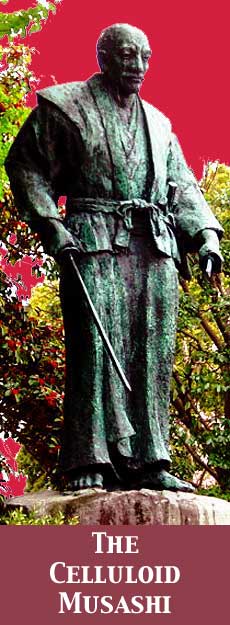


 But in Vagabond Gambler Chiezo was playing a toseinin or peasant wanderer rather than a samurai. Chambara directors had always been willing to let these commoner-swordsmen be portrayed as unruly & badly groomed.
But in Vagabond Gambler Chiezo was playing a toseinin or peasant wanderer rather than a samurai. Chambara directors had always been willing to let these commoner-swordsmen be portrayed as unruly & badly groomed.
 Totsuhei (Tazaki Jun) is a spear-carrier for a young samurai, Shintaro (Akihiko Katayama).
Totsuhei (Tazaki Jun) is a spear-carrier for a young samurai, Shintaro (Akihiko Katayama). Thus in Kurama Tengu Appears in Yokohoma (Kurama Tengu Yokohama ni Arawaru, Daiei, 1942), a gang of ronin defeat foreign interests in the early days of British corruption & illegal smuggling, with reference to the villainous sale by the British of heroin & opium to China, followed by Britain's imperial expansion.
Thus in Kurama Tengu Appears in Yokohoma (Kurama Tengu Yokohama ni Arawaru, Daiei, 1942), a gang of ronin defeat foreign interests in the early days of British corruption & illegal smuggling, with reference to the villainous sale by the British of heroin & opium to China, followed by Britain's imperial expansion.